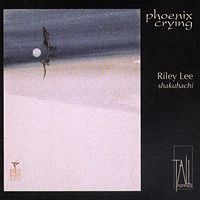
Yearning for the Bell
Riley Lee
plays the shakuhachi -
reviewed by
MALCOLM TATTERSALL'Highly recommended.'
|

|
The flute is a lovely instrument, but it's not perfect. Might we suggest some improvements?
Its lower register is noticeably weaker than the rest of its range. Adding some of the mellow power of the French horn to it would be a clear gain. At the same time, let's increase the dynamic range overall, to approach that of the clarinet.
Tonal variety is generally desirable, too: let's extend it so that it ranges from the most transparent purity to a breathy roar. And vibrato? The standard vibrato of the Boehm flute does give life to its tone, but it might be interesting to be able to vary pitch, volume, and timbre independently and simultaneously.
The flute is noted for its agility, so there's no need to add to that, but let's not lose any either. Oh, but only having twelve notes per octave is a distinct limitation: let's make it not only possible but straightforward to play microtones and true glissandi without loss of tone quality, just as the violin can.
Too good to be true? Not at all: we have just described the shakuhachi, the end-blown Japanese bamboo flute
[listen -- vol 6 track 2, 0:01-1:36].
With all this in its favour, why doesn't it rule the woodwind world? Well, it was developed in the 'wrong' country, so it has a small and (to Westerners) esoteric original repertoire -- and it's fiendishly difficult to play.
Continue >>
Copyright © 24 March 2005
Malcolm Tattersall, Townsville, Australia

|

